The 3ds Max interface provides container commands from the Application menu, Command panel, Tools menu, floating toolbars, and Explorers.
Menu and toolbar commands are useful when working with more than one container. Commands for a single, selected container are activated from the Modify panel.
This topic summarizes each container command group in the interface.

 Application menu
Application menu  References
References  Inherit Container
Inherit Container
Inserts a Source Container into your scene. The scene references the content from its source file.

 Modify panel
Modify panel
Rollouts provide controls for working with a selected container. For command descriptions, refer to Interface.
 Containers
Containers
Right-clicking an empty region of the main toolbar and choosing Containers opens the Container Toolbar with a number of commands for working with containers.
 Containers
Containers
The Containers submenu provides commands that let you inherit containers and edit selected containers in your scene.
 Open Container Explorer / Open Explorer: Container Explorer
Open Container Explorer / Open Explorer: Container Explorer
Container Explorer is a customized version of Scene Explorer. It features a Container Toolbar that lets you inherit containers and edit containers in your scene.
Right-clicking in the table view opens a context menu with the Containers submenu.
If Container Explorer does not display in the Tools menu, do the following:
Right-clicking in the table view opens a menu with a Containers submenu.
To display a Container Toolbar in a regular Scene Explorer, go to the Scene Explorer menu bar and choose Customize  Toolbars
Toolbars  Container.
Container.
 Preferences
Preferences  Containers panel
Containers panel
This panel sets container preferences; in particular, you can use the Status and Update settings to improve performance.
This section describes the container commands available on the Modify panel. Many of these commands are duplicated in the
Scene Explorer and Container Explorer toolbars and submenus, as well as the Tools menu  Containers submenu.
Containers submenu.
The Manage Container rollout lets you open, close, inherit, save, and update containers in your scene. It also lets you convert a Source Container to a unique container.
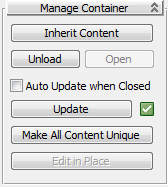
Loads the contents of a MAXC container file, including all its properties, into the selected container. Any existing content in the inheriting container is deleted.
Toggles the loaded state of the container. Displays as Unload when a container is loaded and Load when a Container is unloaded. When unloaded, the container is closed and its contents do not appear in the scene.
Click Unload to save the Container and remove its contents from the scene.
Click Load to load the latest saved version of the Container into the scene and display its contents. The closed/open state before unloading is restored.
Toggles the closed/open state of the container. Displays as Close when the container is open and vice-versa.
Click Close to save the container and prevent any edits or additions to its contents. (The container itself can still be selected, transformed, copied, and so on.)
When you close a container, its contents are saved to a MAXC file and are referenced by the scene, and it can be inherited into any scene as a Source Container. Closing a container can improve scene performance.
Click Open to edit container content. This option is not available for an inherited container if the Rules rollout was set to No Access when the container was saved.
Empties the selected container and reloads its contents from the source file into the scene. It does not Update content that is inherited by the source (in other words, Update does not update changes made to the source of the source). After updating, any changes made to the source container since the previous update, including changes to edit permissions, are present in the updated container.
If the inherited container has a local definition (that is, it was inherited with the rule Only Add New Objects or Anything Unlocked and then saved), updating it keeps any changes you’ve made to the local definition that are not part of the source definition, such as added objects.
The Update command does not apply to unique containers.
When an inherited container is selected, an icon next to the Upate button shows the source container status:
 The inherited container is up to date; no update is needed.
The inherited container is up to date; no update is needed.
 The source container file is newer than the inherited container; an update is needed. Click Update to get the latest version
of the container.
The source container file is newer than the inherited container; an update is needed. Click Update to get the latest version
of the container.
Converts all inherited content, regardless of the source, to be local content. Unique containers can be edited and no longer reference a MAXC file.
Click to edit the contents of a container originating from another user and saved with Rules set to Only Edit In Place. To save your changes and and close the container, click Edit In Place again. Anyone else who then inherits the container will inherit your edits.
Editing an inherited container uses a temporary lock file. For details, see Locked Definitions.
The Local Content rollout lets you edit, refresh, and save containers opened and saved locally on your workstation.
This rollout is hidden if the container is closed or unloaded.
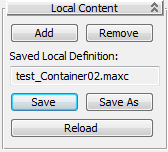
Opens the Add Container Node dialog, which lets you choose objects in the scene to add to the container. To highlight list contents, use the mouse button, optionally in conjunction with Shift or Ctrl. Added contents remain visible in the viewports but are removed from the scene and added to the container’s MAXC source file when the container is closed or unloaded. If the container is deleted from the scene, all objects within it are deleted from the scene as well.
If you add an object that already belongs to a different container, you’re given the option to move the object from its current container to the new one, or cancel by clicking No.
You can add an object to which an XRef Scene is bound, but the binding is lost when you close the container.
Last, it is highly recommended that you not combine grouping actions with containers. That is, do not group a container with other objects, and do not add grouped objects to a container.
Saves the selected container as a new MAXC file.
Two choices are available from the “Save as type” drop down list:
To specify how to convert the unsupported rules Only Add New Objects and Anything Unlocked, use the Preferences  Containers panel
Containers panel  Save to Previous setting.
Save to Previous setting.
The Rules rollout lets the author of the container specify the access level for those who inherit the container. The rules do not apply to local content.
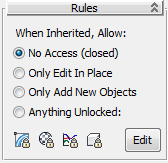
Choose whether and how users who inherit the container have access to its contents:
When you edit a container in place, you have the same level of control over the container as its originator. You can change the rule, lock and unlock tracks, add and delete contents, and so on.
Use this option when passing content around various members of a development team to prevent accidental overwriting of other members’ work.
When you inherit a container with this option set, the container enters the scene in an open state. When you click Close or Save, you’re prompted for a file name. Use a name different from the source container to avoid overwriting it.
Doing so creates a local definition of the container, which stores local edits to the container as well as the reference to the source of the inherited content, which still updates.
When you inherit a container with this option set, the container enters the scene in an open state. When you click Close or Save, you’re prompted for a file name. Use a name different from the source container to avoid overwriting it, thus creating a local definition. While any user has this local definition open, the container is locked so that other users cannot overwrite it.
Subsequent changes to this container, when inherited, are saved in the local version, but not transferred back to the source container. However, changes in the source can still be inherited by updating, with a caveat (see Note, following).
If you add something new that is unlocked, it will be inherited the first time, but never updated. If you delete something, it will be deleted from the container when others update. Similarly, changes in hierarchical relationships among inherited objects are always updated.
The “global” lock toggles described following lock the chosen attributes in the definition file upon save, but not the current scene. You can use any combination of:
 Lock All Modifiers When on, the inheritor cannot edit modifiers of inherited objects.
Lock All Modifiers When on, the inheritor cannot edit modifiers of inherited objects.
 Lock All MaterialsWhen on, the inheritor cannot edit materials applied to inherited objects.
Lock All MaterialsWhen on, the inheritor cannot edit materials applied to inherited objects.
 Lock All TransformsWhen on, the inheritor cannot edit transforms such as rotation keys.
Lock All TransformsWhen on, the inheritor cannot edit transforms such as rotation keys.
 Lock All ObjectsWhen on, the inheritor cannot edit parameters of base objects, such as a sphere’s radius.
Lock All ObjectsWhen on, the inheritor cannot edit parameters of base objects, such as a sphere’s radius.
Opens Track View, where you can use Lock, Unlock, and related commands to specify which attributes are editable (locked controls are not editable). For details, see Locking and Unlocking Tracks.
You can also lock and unlock animation layers.
The Proxies feature lets you temporarily substitute a container file on disk for the selected container. For example, a proxy container can use low-resolution versions of the objects in the original container to free up memory and speed rendering while setting up a scene. Use this feature as an alternative to Unload when you need to reduce scene complexity while still being able to see where objects are in the scene.
You can specify any number of proxies for a container and then use the Definition File drop-down list to swap the different proxies quickly in and out of the scene to control the overall scene complexity. Or simply choose No Proxy to restore the original container.

If you choose Definition File with no proxies defined, a file dialog opens so that you can choose a proxy file. Thereafter the name of the proxy file appears in the text box and the file replaces the original container in the scene.
 Edit
EditOpens the Container Alternate Definitions dialog for editing the list of proxy containers.
On the dialog, use the Add and Remove buttons to change the contents of the list.
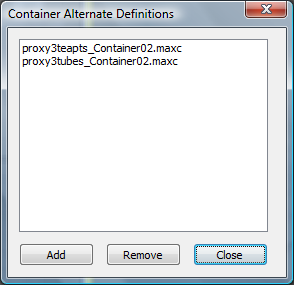
The Inherited Content rollout identifies the path and name of the currently selected Source Container definition, the file that you inherit the content from, and lets you merge its contents into your scene.
This rollout is hidden if the container was created locally.
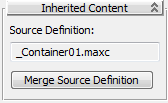
Loads the most recently saved version of the Source Container as the local definition, but does not open or make available for editing any nested containers within, or merge any content that is defined by the source's source.
The Container group lets you set the display properties of the Container helper in your viewports.
To override some of these settings globally, use Display Status in Viewports.
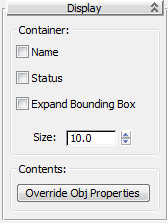
When on, displays the status of the container in the viewport.
Click to ignore the display settings of individual objects in a container, and instead use the display settings defined for the container helper object.
If the container display properties are controlled by layer, only objects in a container which are part of other layers will obey the container layer.
Using the Anything Unlocked rule with a container you create gives you highly fine-grained control over which scene properties a user who inherits the container can edit. This topic explains the related concepts and commands.